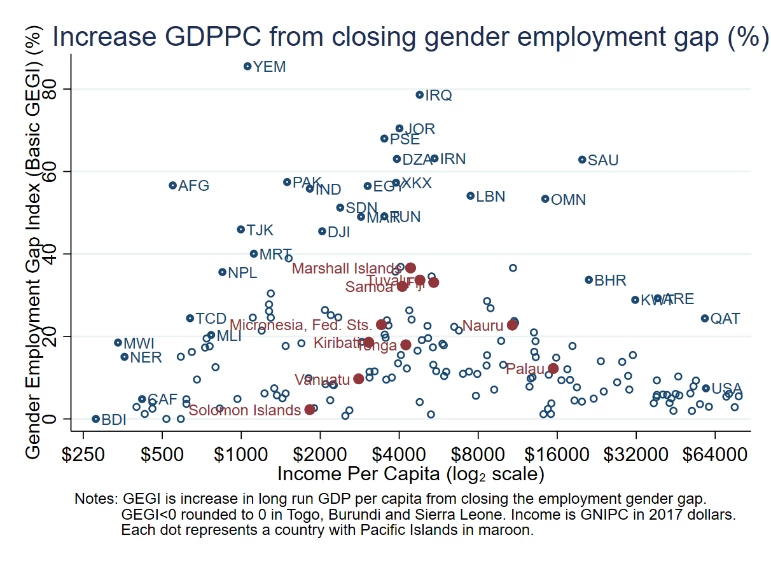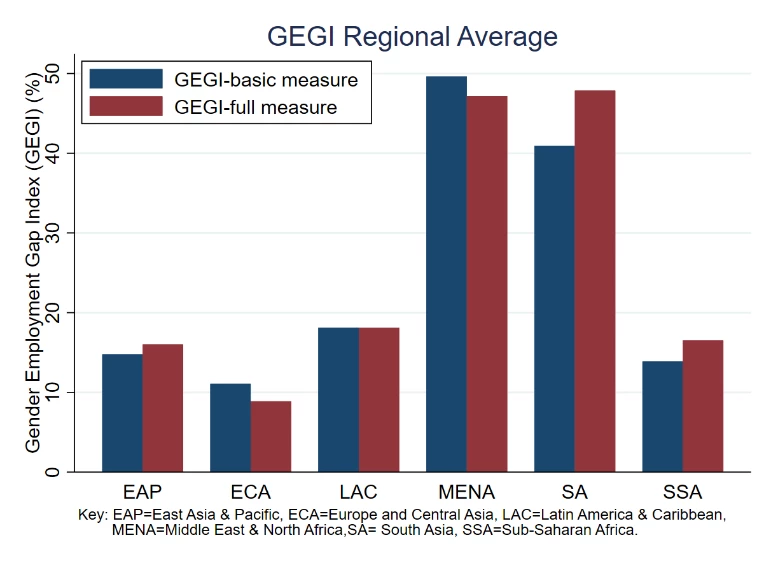 Dmitry Dreyer / Unsplash
Dmitry Dreyer / Unsplash
Despite a near consensus among policymakers that closing gender employment gaps will boost economic growth, missing data often prevents the estimation of the size of these gains for many developing countries. Research over the past decade captures a variety of mechanisms through which higher female employment might boost growth, but greater methodological sophistication in many of these papers requires more data to calculate the size of the gains (and also makes it more difficult to understand how the measures are constructed). These data are not available for many developing countries (especially smaller developing countries). For almost all Pacific Islands countries, for example, there are no estimates of the effect of closing gender employment gaps on GDP, which makes it more difficult for policymakers to make the case for reforms in those countries.
In response to this need, a new working paper develops a Gender Employment Gap Index (GEGI) designed to be a simple and transparent measure of the long-run effects on GDP of closing gender employment gaps that can be calculated for nearly all countries (185). In its basic form, the GEGI is simply calculated as the difference between male and female employment, as a share of total employment, i.e. GEGIbasic=100%×(empMale−empFemale)/empTotal . (An equivalent formula is the difference between male and female employment-to-population ratios, divided by their sum.) The GEGI has this form because it represents the growth rate of employment from increasing female employment until it equals male employment. The index runs from 0% to 100%, with 0% representing countries with no gender employment gaps (male employment=female employment) to 100% where only males are employed.
Despite being simple to calculate, the GEGI is, in fact, equal to the increase in long-run GDP per capita from closing the gender employment gap. It has this interpretation because, in the long run, changes in GDP per capita are proportional to changes in employment, other things being equal. Half to three-quarters of these GDP gains are from the direct effect of extra work by the newly employed women, with the rest due to indirect effects through induced physical capital accumulation (the additional female workers will need additional machinery and equipment to work with, for example).
| Figure 1 |
Figure 2 |
|
|
|
The Gender Employment Gap Index (GEGI) indicates that, on average across countries, long-run GDP per capita would be almost 20% higher if all gender employment gaps were to be closed (Figure 1). The largest gains are in many middle-income countries—especially in the Middle East and North Africa and South Asia regions (Figure 2, blue bars) — where GDP per capita could increase by 40-80% if gender employment gaps were to be closed. In contrast, gains are much smaller in both low-income and high-income countries: likely because women are too poor not to work in the former and tend to have better employment opportunities in the latter. The GEGI averages 22% across 11 Pacific Island countries (highlighted in maroon in Figure 1) but varies greatly from close to zero to almost 40% depending on the country considered. (The GEGIs for all countries can be downloaded here).
While all the mechanisms included in the GEGI are important, not all important mechanisms are included in the GEGI. The GEGI’s simplicity also means that it is an approximation, and might underestimate the size of GDP gains for some countries. To partially address this, the GEGI working paper also calculates a “full GEGI” which takes account of whether gender gaps are in “better employment” (types of work associated with higher productivity) or other types of employment. The full GEGI turns out to be very similar to the basic GEGI (Figure 2 red bars). The GEGIs are also highly correlated with more comprehensive alternative measures in several other studies (correlation above 95% across regions), though the GEGIs are typically smaller.
One final takeaway is that the estimated GDP gains from closing gender employment gaps are extremely heterogenous across developing countries (Figure 1). This means that one-size-fits-all motivations for gender policy reforms in developing countries will be inappropriate, and discussions should instead be tailored to the country context . For example, in some countries closing gender employment gaps is likely to have a large effect on GDP, whereas in other countries broader gender benefits (such as greater empowerment) may be more important.
The Gender Employment Gap Index was commissioned by the World Bank’s Pacific Gender Equality Program.




Join the Conversation